Thank you for visiting my blog! 😍😍😍
I like making design handmade decorative pillows in my free time.It is very very enjoyable hobby for me.I am interested in making handmade pillows since 5 years.
So my adventure started...
I like making design handmade decorative pillows in my free time.It is very very enjoyable hobby for me.I am interested in making handmade pillows since 5 years.
So my adventure started...
I use eco friendly textile fabrics and stuffing materials for them.I like seeing my products around the world.It is amazing and exciting! 😎😎
You can give these knot handmade pillows as a christmas or birthday gift to your loved ones !💗💙💚💛💜💓🎁
You can give these knot handmade pillows as a christmas or birthday gift to your loved ones !💗💙💚💛💜💓🎁
Best gifts for all design lovers! It is also nice idea who wants to create nice difference in their home decor.😉😉😉
Please feel free to contact us 👇👇👇
https://www.etsy.com/people/plusgen
Please feel free to contact us 👇👇👇
https://www.etsy.com/people/plusgen
You can choose another color option or send me message according to your color wish. My one of favorite color is black knot pillows.

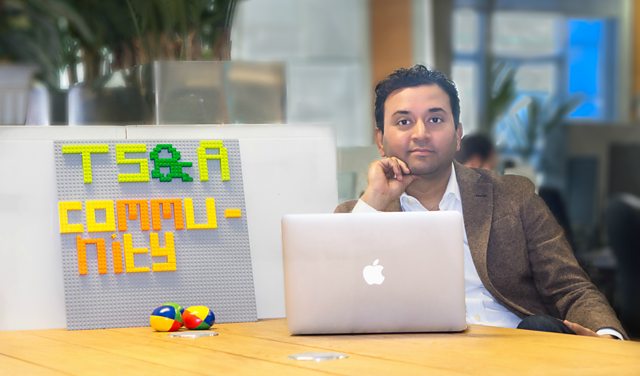
Today marks an exciting milestone for Mixital. The BBC’s creativity website is launching a digital tool conceived, designed and built by young people in partnership with BBC Radio 1Xtra. The Mixital Youth Panel is the team behind this innovation. They are a digitally savvy group of creatives, coders and designers who work with the BBC’s Digital Creativity team to develop the site for young people.
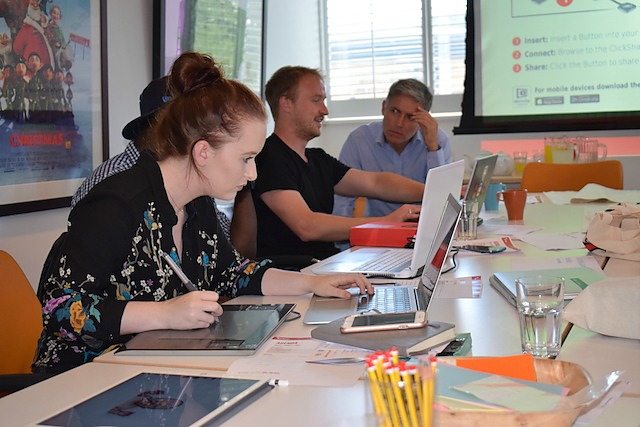
The panel, formed in March 2016, meets the BBC team every six weeks. They wanted to expand their advisory role to get hands-on experience of digital production. And we were all excited by the vision of Mixital being made by young people for young people.
Mixital is ideal for this kind of innovation. At its heart is the ‘maker kit’. These kits enable users to make and then publish games, stories, scripts and even upload videos. They are designed to build digital skills and confidence while transforming digital consumers into creators. BBC brands like EastEnders, Strictly, Doctor Who and BBC Three are already using them. The brand simply chooses how it wants to engage creatively with its fans.
Mixital is ideal for this kind of innovation. At its heart is the ‘maker kit’. These kits enable users to make and then publish games, stories, scripts and even upload videos. They are designed to build digital skills and confidence while transforming digital consumers into creators. BBC brands like EastEnders, Strictly, Doctor Who and BBC Three are already using them. The brand simply chooses how it wants to engage creatively with its fans.

But could the panel really build one of these maker kits? Could they persuade a BBC brand to support it? And what about all the other aspects of digital production like design, testing and marketing? We knew the scale of the challenge. But believed a combination of the panel’s passion and BBC mentors might just pull it off.
We broke the process into four stages:
Pitch. The panel developed ideas and prepared their pitches. The winning pitch was a proposal to build a kit for 1Xtra that would enable fans to submit ideas to its Breakfast Show. The panel loved the show’s presenter A.Dot and her ‘Trashbag Tuesday’ item. She encourages fans to send in their gripes and then consigns them to the dustbin.
Design. The panel then worked closely with the 1Xtra team and A.Dot herself to design the visual elements. They had to ensure everything, including the animation of A.Dot herself, were a good ‘fit’ for the show.
Production. Then the panel travelled to Bristol to work with Aardman Digital. Aardman, who had built the original kits, created a simplified process for modifying them. It meant the panel were able to create their own kit without having to build it from scratch.
Launch. And finally the panel prepared it for launch. They ran it through a series of quality tests including with a live audience at the Birmingham Skills show. They then worked with the marketing and comms teams to ensure it would find an audience.
We broke the process into four stages:
Pitch. The panel developed ideas and prepared their pitches. The winning pitch was a proposal to build a kit for 1Xtra that would enable fans to submit ideas to its Breakfast Show. The panel loved the show’s presenter A.Dot and her ‘Trashbag Tuesday’ item. She encourages fans to send in their gripes and then consigns them to the dustbin.
Design. The panel then worked closely with the 1Xtra team and A.Dot herself to design the visual elements. They had to ensure everything, including the animation of A.Dot herself, were a good ‘fit’ for the show.
Production. Then the panel travelled to Bristol to work with Aardman Digital. Aardman, who had built the original kits, created a simplified process for modifying them. It meant the panel were able to create their own kit without having to build it from scratch.
Launch. And finally the panel prepared it for launch. They ran it through a series of quality tests including with a live audience at the Birmingham Skills show. They then worked with the marketing and comms teams to ensure it would find an audience.
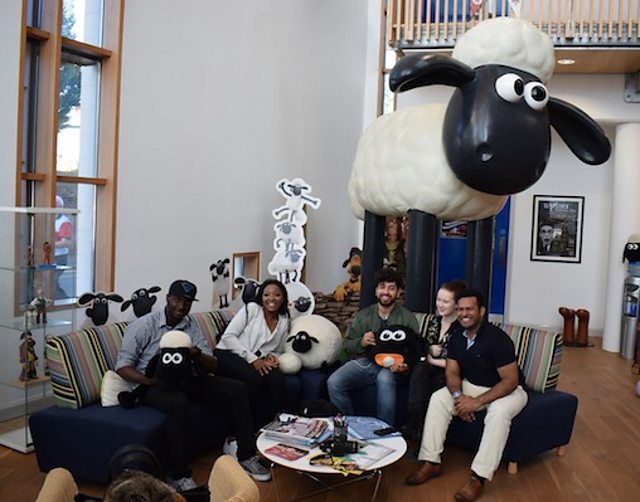
Over just four months, the panel had the invaluable experience of end-to-end digital production: from conception to launch. Today’s the big day. We’re all going to be incredibly proud when we hear A.Dot herself launch the new tool on air and call on her fans to use it.
1Xtra have been the ideal partner. They have demanded a high-quality product for their audiences while being supportive and encouraging throughout.
A.Dot said: “It's really exciting to launch the Trashbag Tuesday animation maker on my show. This is a really innovative project and it will inspire young people to get creative. The best part is that it was designed and built with the help of the BBC Mixital youth panel - this is a great example of the BBC helping young people to develop their Digital skills.”
Panellist Kian Bakhtiari, said: “This was an immensely rewarding experience for all of us since we were able to play a central role in creating A.Dot’s Trashbag Tuesday kit. Being involved in the project from start to finish has enhanced our digital skills as creatives.” The Digital Creativity team’s mission is to boost the digital skills of young people. So what a great development that young people are now playing such a key role themselves in that mission.
1Xtra have been the ideal partner. They have demanded a high-quality product for their audiences while being supportive and encouraging throughout.
A.Dot said: “It's really exciting to launch the Trashbag Tuesday animation maker on my show. This is a really innovative project and it will inspire young people to get creative. The best part is that it was designed and built with the help of the BBC Mixital youth panel - this is a great example of the BBC helping young people to develop their Digital skills.”
Panellist Kian Bakhtiari, said: “This was an immensely rewarding experience for all of us since we were able to play a central role in creating A.Dot’s Trashbag Tuesday kit. Being involved in the project from start to finish has enhanced our digital skills as creatives.” The Digital Creativity team’s mission is to boost the digital skills of young people. So what a great development that young people are now playing such a key role themselves in that mission.
If you’re looking for a new challenge in 2017, there are a number of fantastic new opportunities to join the team working to digitally transform the BBC World Service.
The World Service is an extraordinary and unique organisation; it is the world’s largest international broadcaster, reaching over 320 million people every week on Radio, TV and Online in 29 different languages.
In November we announced the biggest expansion of the World Service since the 1940s — which presents a huge, yet complex, technical challenge to launch new broadcast and digital services in a further 11 languages. The programme is called World 2020; we will be establishing new broadcast infrastructure, and updating our news gathering and production processes as more journalists are hired in Africa, Asia, Russia and the Middle East.
As the service expands we are looking to digitally transform how we operate and deliver content to users. There is a massive shift in consumption of news to mobile phones, and this means we need to create and publish our content in new ways, both on BBC websites and apps, as well as social media platforms that are being used by audiences in the countries in which we are expanding.
We already have a fantastic team of designers, developers, product managers and testers who have expertise in deploying digital products responsively in 27 languages, but we are looking to expand the team to allow us to meet the new challenges of the World 2020 programme.
The World Service is an extraordinary and unique organisation; it is the world’s largest international broadcaster, reaching over 320 million people every week on Radio, TV and Online in 29 different languages.
In November we announced the biggest expansion of the World Service since the 1940s — which presents a huge, yet complex, technical challenge to launch new broadcast and digital services in a further 11 languages. The programme is called World 2020; we will be establishing new broadcast infrastructure, and updating our news gathering and production processes as more journalists are hired in Africa, Asia, Russia and the Middle East.
As the service expands we are looking to digitally transform how we operate and deliver content to users. There is a massive shift in consumption of news to mobile phones, and this means we need to create and publish our content in new ways, both on BBC websites and apps, as well as social media platforms that are being used by audiences in the countries in which we are expanding.
We already have a fantastic team of designers, developers, product managers and testers who have expertise in deploying digital products responsively in 27 languages, but we are looking to expand the team to allow us to meet the new challenges of the World 2020 programme.
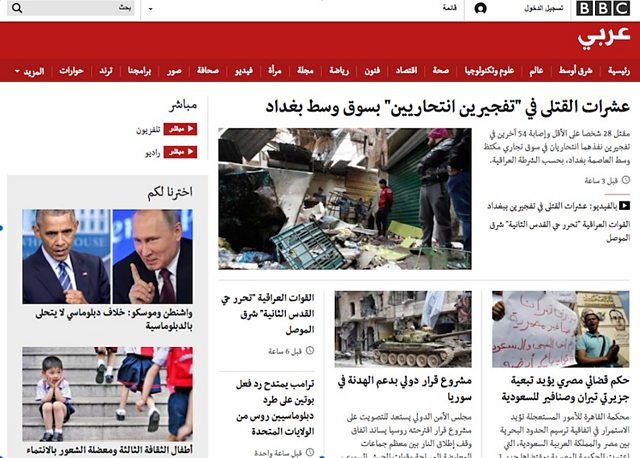
The existing BBC Arabic responsive website
New projects will include scaling our publishing solutions for messenger based platforms, and taking some of the recent innovations prototyped by BBC News Labs into full production.
If you have a passion for news, for languages technology and digital innovation, and a belief in the impact we can have together through the World Service, we would love to hear from you. We have vacancies in the following roles:
- Principle Software Engineers (web / apps)
- Senior Software Engineer (data systems)
- Software Engineer (Frameworks & Tools)
- Testers
- UX Designers
- Business Analysts
The roles are based mainly in London in New Broadcasting House, co-located with many of the journalists creating content and driving the editorial innovations that are part of the World 2020 programme.
We will be running a first round of interviews in January, so do get in touch with your CV if you would like to be considered for one of the roles. Send emails to Laura.Rowley@bbc.co.uk.
This is a great opportunity to join a team that is embarked on a unique global programme of change. We look forward to hearing from you.
If you have a passion for news, for languages technology and digital innovation, and a belief in the impact we can have together through the World Service, we would love to hear from you. We have vacancies in the following roles:
- Principle Software Engineers (web / apps)
- Senior Software Engineer (data systems)
- Software Engineer (Frameworks & Tools)
- Testers
- UX Designers
- Business Analysts
The roles are based mainly in London in New Broadcasting House, co-located with many of the journalists creating content and driving the editorial innovations that are part of the World 2020 programme.
We will be running a first round of interviews in January, so do get in touch with your CV if you would like to be considered for one of the roles. Send emails to Laura.Rowley@bbc.co.uk.
This is a great opportunity to join a team that is embarked on a unique global programme of change. We look forward to hearing from you.
Since a European Court of Justice ruling in 2014, individuals have the right to request that search engines remove certain web pages from their search results. Those pages usually contain personal information about individuals.
Following the ruling, Google removed a large number of links from certain search results, including some to BBC web pages, and continues to delist BBC Online pages from some search results. These pages are not removed from the Google index entirely, or from BBC Online.
As a contribution to public policy and debate, the BBC has decided to make clear to licence fee payers which pages have been impacted by publishing this list of links.
Each month, we’ll update the list, with the latest removals added at the top. Removals made in 2016 are listed below and those made in 2014 and 2015 can be found here.
You can also find out more about the BBC’s archive policies in my first blog post on this topic published in June 2015.
One important caveat: when looking through this list it is worth noting that we are not told who has requested the delisting, and we should not leap to conclusions as to who is responsible. The request may not have come from the obvious subject of a story.
Following the ruling, Google removed a large number of links from certain search results, including some to BBC web pages, and continues to delist BBC Online pages from some search results. These pages are not removed from the Google index entirely, or from BBC Online.
As a contribution to public policy and debate, the BBC has decided to make clear to licence fee payers which pages have been impacted by publishing this list of links.
Each month, we’ll update the list, with the latest removals added at the top. Removals made in 2016 are listed below and those made in 2014 and 2015 can be found here.
You can also find out more about the BBC’s archive policies in my first blog post on this topic published in June 2015.
One important caveat: when looking through this list it is worth noting that we are not told who has requested the delisting, and we should not leap to conclusions as to who is responsible. The request may not have come from the obvious subject of a story.
Picking a Service Design technique
With this in mind, at the beginning of this year I started to look at approaches that would allow us to both widen the focus of our research, and gain a view of the tools from the standpoint of the users. We had already applied several mapping techniques to internal tools - such as experience mapping from Adaptive Path - but we had been focusing on specific tasks, e.g. uploading a video to used in an article. This time, with the aim of learning about totally unknown issues, we wanted to understand the full range of tools people were using and how they used them - not just thinking about predetermined sub-tasks with specific software. By looking at examples from other companies facing similar problems, and from personal experience, a Service Design approach seemed a good choice because of three main characteristics:- The use of ethnography, as we needed to immerse ourselves in the world of BBC staff.
- Co-design techniques, to involve users in designing the solutions to their own problems, from their own perspective.
- Holistic thinking; the ability to see the tools as part of a wider ecosystem.
A process of change
Although it may appear basic, this assumption changed the perception of our own work. We had to employ ethnographic observation and contextual enquiry more accurately than ever before, and Service Design pushed us to acquire new skills and sensibilities in the area of strategic design thinking practice. I was enthusiastic about this point, as it fitted with the way our design team could work with the product teams in a truly cross-functional fashion. This implied going beyond what we were already doing as UX designers, which consisted in applying Lean UX within pre-set agile teams, as exemplified by Jens Otto Lange’s model for design teams in Software organisations. Familiarisation with Service Design was therefore the first step in this long process of change.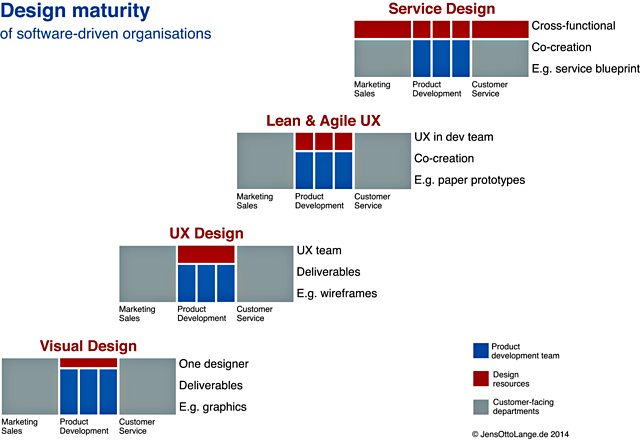
Models of progression of design teams in Software organisations (copyright: Jensottolange.de) from Touchpoint Vol. 6 No. 3 - December 2014
How we did it
After deciding on the technique, our next task was to select an area of the business to study, which would offer tangible information within the limited timeframe we had available. We focussed on shadowing journalists during their daily shifts in the BBC Birmingham Newsroom.
Our observations confirmed that teams were using a far wider set of digital tools. While our assumptions on how editors and journalists perceived our production systems were on the whole confirmed, we also saw that their working practices included not just digital software, but also other things such as 24/7 tech assistance, specific News software, broadcast management platforms, video-editing, emails and training. We were then able to identify potential pain-points that weren’t specific to any single tool, but rather arose through the interaction between non-digital elements (such as phone calls and print-outs) and software. This level of detail is something we wouldn’t have achieved solely through traditional interviews and testing focussed on usability issues and software usage.
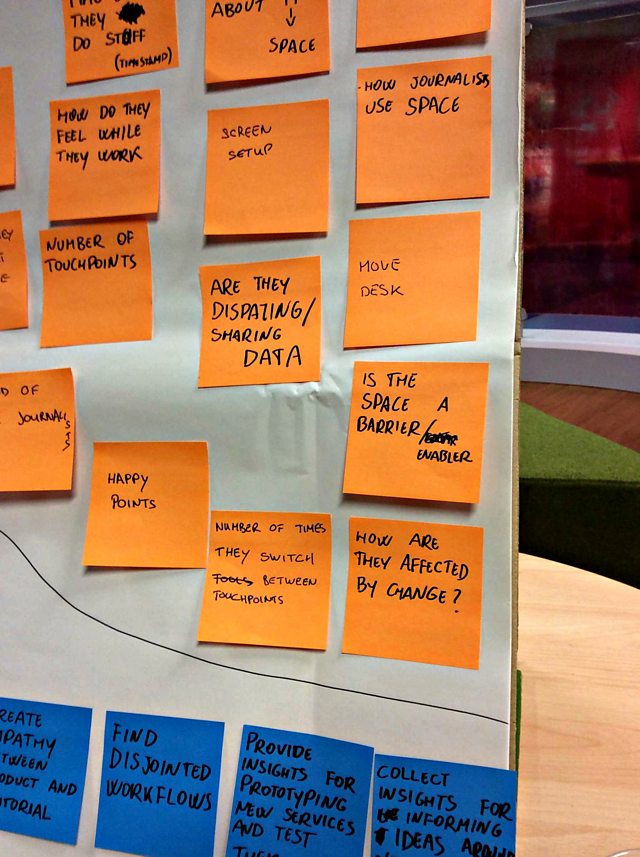
Before the observation: thinking about what we wanted to find out
Decoding together is key
The next stage was to collate and present our data. We saved all of our findings digitally, making them accessible to everyone, then focussed our attention on the high number of tools and the ways in which teams interacted with them. We then went through a huge set of field notes, pictures and recordings, transcribing all the notes on post-its and print-outs on the wall in order to capture the full environment journalists work in.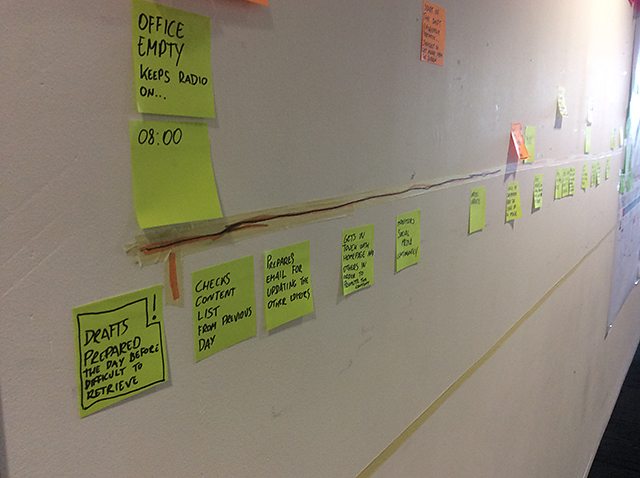
Our wall during the decoding session
We were now able to transfer this information onto service blueprints, showing the different phases of a journalist’s ideal working shift. We shared these with the Product teams, in one-to-one meets with business analysts’s and product owners, feedback sessions with developers and designers, and via email to wider groups in order to initiate a conversation with our colleagues across the UK.

UX wall, with the Blueprints on the far end
Key findings and outcomes
Although the blueprints only covered a few profiles in their first iteration, they immediately resonated with team conversations, data from other streams of research and software trials, strategic plans, and first-hand knowledge in the team. They had the benefit of making the pain points of the users clear, but more importantly, they made manifest how tools were perceived as a unified service, especially to people new to the organisation.In our daily design activity, the key outcomes of the blueprints have been:
1. Strengthening of cross-functional initiatives, such as our shared pattern library for increasing consistency across the tools
2. A clear business case for small design quick-wins - for instance adopting a common vocabulary (e.g. document status names) across the tools
3. A solid foundation of user knowledge, which could be used in interdisciplinary activities such as Design Sprints
In the longer term and in regard to organisational change and improvement, the outcomes were:
4. Developing the capability for UX teams to tackle complex issues and share actionable understanding in cross-discipline teams
5. The development of a circle of trust with the journalists and the editors, and a push for adopting a co-design approach more consistently, to include even more users in the design of features and priorities
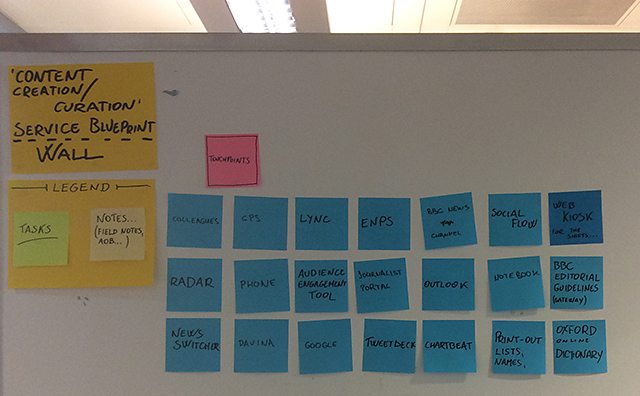
The touchpoints listed on our wall
It was encouraging when we discovered that people were spontaneously taking snapshots of some of the wall items, and including them in their documents and presentations. This was a sign we were working in the right direction for introducing and sharing a new approach within the organisation, and that there was an appetite to reflect together. By creating these blueprints, we've learnt some new skills and practice in co-design and ethnographic research. We've evolved our design-based approach to complex problems. This is extremely helpful for putting the user needs at the core of our everyday activity and influencing the long-term strategic thinking of our organisation.
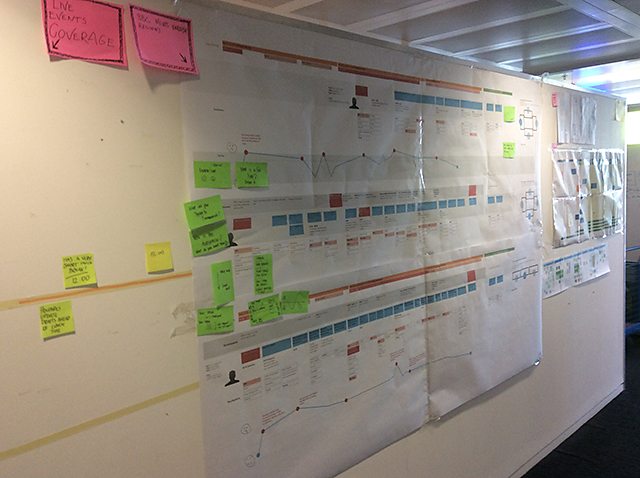
The blueprints after some feedback sessions
What did not work
After some specific feedback around the first version of the blueprint, we realised that we were incorporating far too many details in the posters, and the ‘story’ we wanted to tell subsequently came across as too deep. The blueprints were difficult to read and empathise with, and this stopped people really engaging. As a result, we are currently working on a second version of the posters. We aim to improve their legibility and storytelling, so they are clearer and easier to take in, with more actionable insights focused on specific software issues that everyone in the product teams can familiarise with.Although we engaged users and journalists, we have not yet managed to kick-off any long-term co-design activity. This is definitely part of our next objectives.
Next Steps
The idea is to go further with exploring and mapping areas of the BBC in this way - involving more users and members of the teams in the discussion, and including co-creation - where people using the tools would be more actively involved in their definition. The months ahead are promising, as our department has put in place a new strategy for integrating all of the tools. Plus, the BBC UX&D team have included Service Design in its objectives for this year, so it will be a good time to experiment and put these approaches to work within the organisation.
This week saw the introduction of portrait (or vertical) video in the BBC News app, available on Android and iOS. James Metcalfe is Executive Product Manager for BBC News apps and Connected TV and gives more information on this new feature.
Portrait video will enable you to swipe through a curated list of ‘videos of the day’, getting latest news in an easy-to-consume and engaging format. For the first time you will be able to watch full screen video created just for mobile.
With more and more of our News audience coming to us exclusively via mobile devices, we are continually looking for new ways to make our video journalism available to that mobile-only audience. The apps team has been collaborating closely with our editorial and video production colleagues across the BBC to look at everything from the way we shoot and edit news video through to the user experience in the app.
We have been testing this vertical video service with ‘beta’ audiences for a few months, but with today’s app update roll out we expect to learn even more about what our smartphone audience is looking for.
So why have we focused on video in the app? Video viewing on mobile and on our apps has been increasing dramatically. Last year when we released the new version of the app, weekly video views increased by more than 200% when compared to the old version in the previous year. Our apps users now watch 48% of all of the video published by BBC News online and a quarter of those who watch video are watching more than five clips per week.
Despite the increase in video views we know, through audience feedback, there were several reasons people were not watching our video on mobiles: Most of our video has traditionally required sound, which can be a problem when viewing in public and much of the video was embedded in small screens making it hard to watch without rotating the phone. In addition, much of our video offer has so far consisted of longer TV pieces that aren’t ideal if you’re after a quick update and short of time.
Our new vertical video addresses all those issues. It will be shorter than films used elsewhere on the BBC and tell news stories in a succinct and snappy way. In addition, all of our vertical videos are subtitled and can be used without the sound on.
We have been testing this update and the videos with different groups of people for a number of months and the response has been largely positive. We really appreciate the feedback of the thousands of users who have been involved so far and we will continue to improve this feature and many others in the apps over the coming months.
With more and more of our News audience coming to us exclusively via mobile devices, we are continually looking for new ways to make our video journalism available to that mobile-only audience. The apps team has been collaborating closely with our editorial and video production colleagues across the BBC to look at everything from the way we shoot and edit news video through to the user experience in the app.
We have been testing this vertical video service with ‘beta’ audiences for a few months, but with today’s app update roll out we expect to learn even more about what our smartphone audience is looking for.
So why have we focused on video in the app? Video viewing on mobile and on our apps has been increasing dramatically. Last year when we released the new version of the app, weekly video views increased by more than 200% when compared to the old version in the previous year. Our apps users now watch 48% of all of the video published by BBC News online and a quarter of those who watch video are watching more than five clips per week.
Despite the increase in video views we know, through audience feedback, there were several reasons people were not watching our video on mobiles: Most of our video has traditionally required sound, which can be a problem when viewing in public and much of the video was embedded in small screens making it hard to watch without rotating the phone. In addition, much of our video offer has so far consisted of longer TV pieces that aren’t ideal if you’re after a quick update and short of time.
Our new vertical video addresses all those issues. It will be shorter than films used elsewhere on the BBC and tell news stories in a succinct and snappy way. In addition, all of our vertical videos are subtitled and can be used without the sound on.
We have been testing this update and the videos with different groups of people for a number of months and the response has been largely positive. We really appreciate the feedback of the thousands of users who have been involved so far and we will continue to improve this feature and many others in the apps over the coming months.
The BBC recently held its 3rd annual ‘Future of Music’ industry conference. As part of the event, we invited along start-ups to demo their products and music experiences to the attendees. Cyrus Saihan is Head of Digital Partnerships and explains more about how technology is continuing to transform the music industry.
If someone had told you 10 years ago that they could have a conversation with their hi-fi speaker, be virtually teleported to a music festival from their living room and carry millions of songs with them wherever they went, it is unlikely that you would have believed them.
Today, experiencing music in such ways is increasingly commonplace. Advances in technology have brought about dramatic changes to the way that we listen to, buy and interact with music and radio. Driven by the rapid growth of devices such as smartphones and tablets, new digital music services and formats have emerged, with innovation taking place across the music and radio industry.
Today, experiencing music in such ways is increasingly commonplace. Advances in technology have brought about dramatic changes to the way that we listen to, buy and interact with music and radio. Driven by the rapid growth of devices such as smartphones and tablets, new digital music services and formats have emerged, with innovation taking place across the music and radio industry.
Future of Music Conference 2016
On Friday 4th November we held a half-day ‘Future of Music’ conference, bringing together industry experts from across the sector to discuss and debate how digital music and innovation is likely to impact the music and radio industry in the coming years.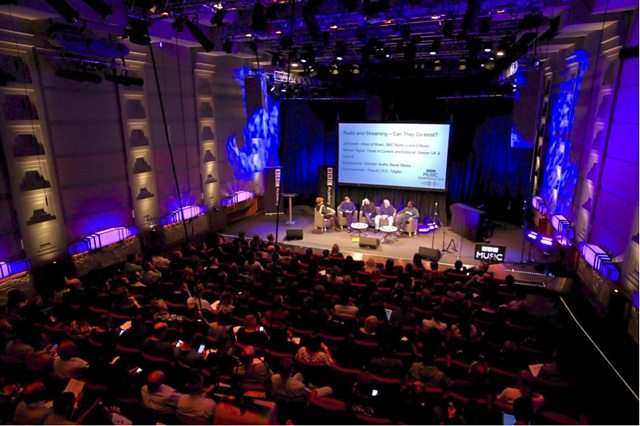
A panel discussion at our Future of Music 2016 conference
From Guglielmo Marconi transmitting the first radio waves across the earth (from the Isle of Wight to Cornwall) to the music of some of the world’s biggest selling acts such as the Beatles and Adele, the UK has always been a major influencer and innovator when it comes to music.
It is exciting to consider what could come next from the UK’s music industry.
With that in mind, as part of our Future of Music conference, we invited along some interesting start-ups to demo their products and services to the attendees. We had a variety of start-ups at the event, ranging from one that uses artificial intelligence to write new songs, to one that has created a ‘3D’ music controller that allows you to manipulate sounds just by moving your hand around in thin air.
It is exciting to consider what could come next from the UK’s music industry.
With that in mind, as part of our Future of Music conference, we invited along some interesting start-ups to demo their products and services to the attendees. We had a variety of start-ups at the event, ranging from one that uses artificial intelligence to write new songs, to one that has created a ‘3D’ music controller that allows you to manipulate sounds just by moving your hand around in thin air.

An attendee trying out a ‘mixed reality’ experience
Artificial intelligence and music

Jukedeck demoing their artificial intelligence music creator
Set up in 2014 by two Cambridge University graduates, Jukedeck is training ‘neural networks’ (computer systems modelled on the way that the human brain solves problems) to create new and unique tracks in a matter of seconds. As well as individual content creators looking for some customised music (that they will then own the exclusive copyright to), Jukedeck’s technology is also being used by Google, the Natural History Museum and even the Royal Family.
Virtual reality – inviting artists into your living room
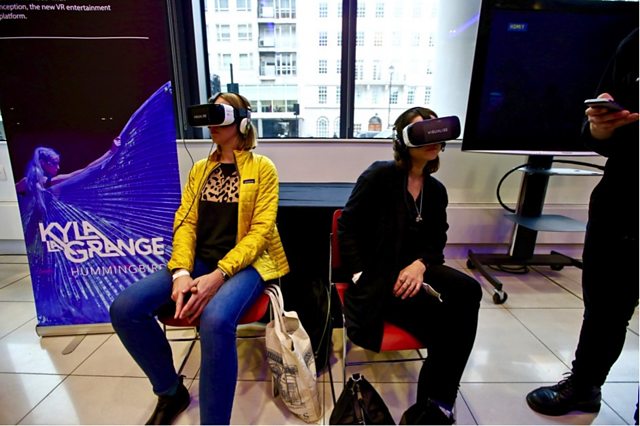
Attendees trying out a virtual reality music experience created by the team at Visualise
With the increasing capabilities of virtual reality headsets, the last couple of years have seen the emergence of production companies focussing on virtual reality and immersive experiences. Visualise is a UK based company that has produced a variety of 360 degree videos and virtual reality content across a range of genres ranging from sport to entertainment.
The new medium of virtual reality holds great potential for the music industry. Technologies like this will bring fans closer to the artist and allow them to experience music in a unique and incredibly immersive way – imagine sitting in your living room and being able to feel as if you had been teleported to the front row of a stadium concert in another part of the world or feel as if your favourite artist was singing just for you.
The new medium of virtual reality holds great potential for the music industry. Technologies like this will bring fans closer to the artist and allow them to experience music in a unique and incredibly immersive way – imagine sitting in your living room and being able to feel as if you had been teleported to the front row of a stadium concert in another part of the world or feel as if your favourite artist was singing just for you.
3D music controllers
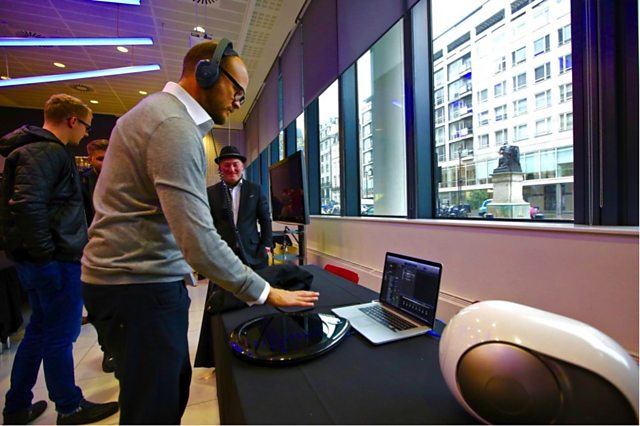
The Titan Reality ‘3D sensing’ device in action
Titan Reality has created a ‘3D sensing’ device that uses artificial intelligence and gives individuals a whole new way to manipulate sound and lighting. We were lucky enough to have one of only a handful of Titan Reality devices in the world at the event. By simply floating and moving your hand above the device, it is possible to change the tone and pitch of sounds, switch instruments and add in effects. It was exciting to see the device in action and how it offers a user with little musical instrument training the ability to create unique soundscapes. As well as the music industry, the company is also looking at how the device can be used in other areas such as controlling industrial robots by using machine vision technology.
Broadcast your own radio station from your phone
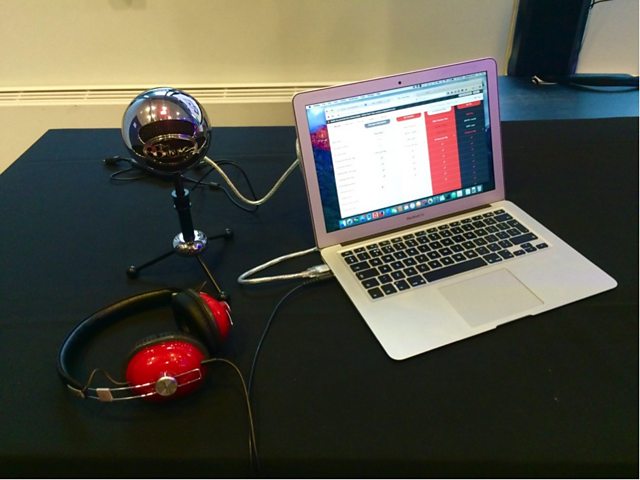
A simple Mixlr set up
Artists, DJs and bands are increasingly using new technologies and online platforms to reach audiences around the world and Mixlr is looking to capitalise on that trend. Founded in 2010, the company has built an app that allows users to live stream their performances to fans around the world (for example via a band’s own website) and at the same time share that broadcast on social media outlets and on-demand music platforms. As you can see from the image above, the set-up is simple, making what has traditionally been a complex operational challenge accessible to a much wider audience.
The start-ups and technologies that demoed at our Future of Music 2016 event give us a glimpse into how digital technology will change the future of the music and radio industry.
Not that long ago, a portable cassette player seemed to be the cutting edge of technology – now they are considered retro collectible antiques. Today, smartphones are the driving forces of change in the music industry. And who knows, in years to come we might look back nostalgically on the smartphone era as we walk around with chips implanted into our brains and have our music beamed directly to us!
We are always looking out for ways to bring third party innovation into the BBC to help us explore how we can use new technologies to create new types of content and experiences for our audiences. If you have any innovation ideas or technologies that you think our audiences could potentially benefit from, do get in touch in the comments section below or contact me on Twitter @cyrussaihan.
The start-ups and technologies that demoed at our Future of Music 2016 event give us a glimpse into how digital technology will change the future of the music and radio industry.
Not that long ago, a portable cassette player seemed to be the cutting edge of technology – now they are considered retro collectible antiques. Today, smartphones are the driving forces of change in the music industry. And who knows, in years to come we might look back nostalgically on the smartphone era as we walk around with chips implanted into our brains and have our music beamed directly to us!
We are always looking out for ways to bring third party innovation into the BBC to help us explore how we can use new technologies to create new types of content and experiences for our audiences. If you have any innovation ideas or technologies that you think our audiences could potentially benefit from, do get in touch in the comments section below or contact me on Twitter @cyrussaihan.
The BBC iPlayer Radio website and BBC iPlayer Radio mobile app provide access to almost 60 separate stations, most of which broadcast new programmes 24 hours a day, seven days a week. As well as all that live programming there’s also a wealth of on demand programmes and clips available for you to catch up on. We recently checked how many on demand programmes were available and counted almost 150,000; a number that is set to continue rising.
This wealth of programming brings with it a challenge that isn’t unique to BBC Radio: how can you discover the things you love in amongst all those items? If you’ve got an idea of what you want then we have ways of helping you find it such as our search tool, the broadcast schedules for our stations or particular categories like ‘comedy’ or ‘drama’. But if you don’t really know what you’re after then it can be hard to know where to start.
Earlier this year we released new versions of all our station homepages to see if we could help with this issue. Our aim was to make the homepages do a better job of showing you our pick of the best of BBC Radio. Since we launched the new homepages, the proportion of people visiting those pages who click something on them has almost doubled, which is a significant improvement.
However the problem remains that when we pick out the best of BBC Radio we’re not taking account of your own personal listening preferences. This calls for a different approach, which we’re calling My Radio. It works by keeping track of the BBC Radio programmes you listen to online in order to help you keep up with the programmes that you love and introduce you to new programmes we think you’ll enjoy. We’re starting out with a relatively simple version, which includes some features we already have and some new ones. We’ll measure how well these features are doing and refine them, as well as introducing new ones to help you get the most out of BBC Radio online. The home for these features can be found here. In order for these to work you must be signed in to your BBC account.
This wealth of programming brings with it a challenge that isn’t unique to BBC Radio: how can you discover the things you love in amongst all those items? If you’ve got an idea of what you want then we have ways of helping you find it such as our search tool, the broadcast schedules for our stations or particular categories like ‘comedy’ or ‘drama’. But if you don’t really know what you’re after then it can be hard to know where to start.
Earlier this year we released new versions of all our station homepages to see if we could help with this issue. Our aim was to make the homepages do a better job of showing you our pick of the best of BBC Radio. Since we launched the new homepages, the proportion of people visiting those pages who click something on them has almost doubled, which is a significant improvement.
However the problem remains that when we pick out the best of BBC Radio we’re not taking account of your own personal listening preferences. This calls for a different approach, which we’re calling My Radio. It works by keeping track of the BBC Radio programmes you listen to online in order to help you keep up with the programmes that you love and introduce you to new programmes we think you’ll enjoy. We’re starting out with a relatively simple version, which includes some features we already have and some new ones. We’ll measure how well these features are doing and refine them, as well as introducing new ones to help you get the most out of BBC Radio online. The home for these features can be found here. In order for these to work you must be signed in to your BBC account.
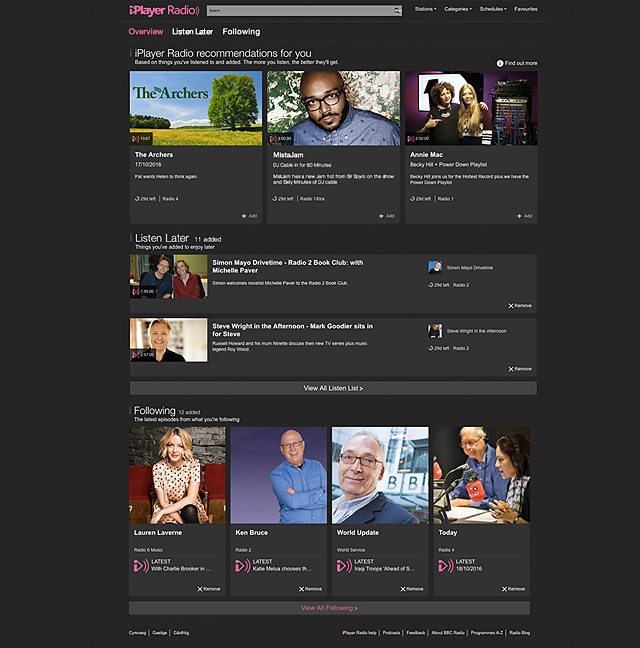
The My Radio page on the iPlayer Radio website
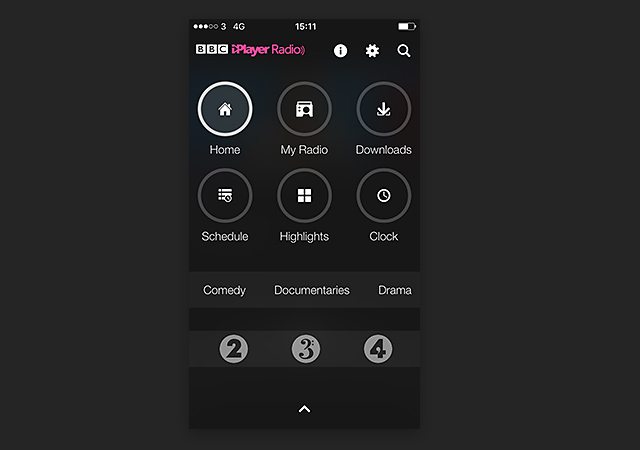
My Radio on the iPlayer Radio mobile app menu
Existing features which form part of My Radio include 'Listen Later' (previously called ‘Listen List’ and only available on the website) which gives you the ability to save things for later and ‘Following’ which allows you to see the latest available programme from your favourite shows. We’re introducing ‘Listen Later’ for the first time to the iPlayer Radio mobile app. You’ll be able to access these features on any device where you’re signed in to your BBC account.
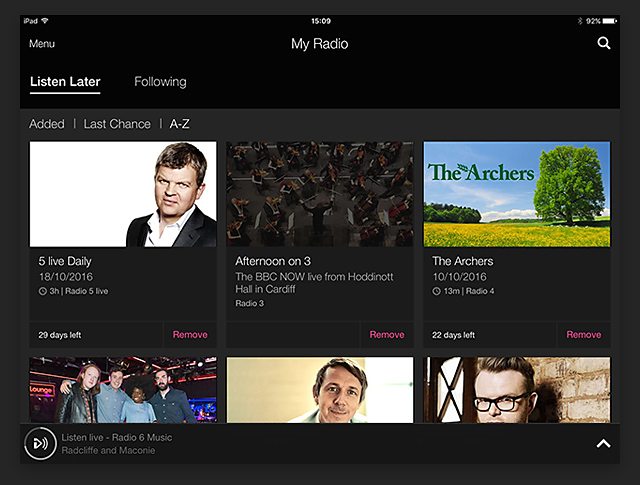
Listen Later on the iPlayer Radio mobile app
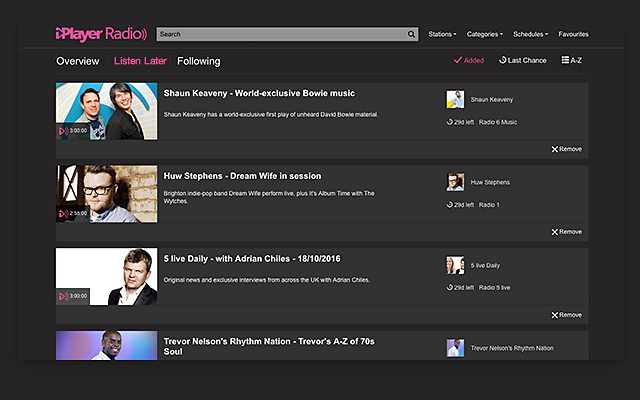
Listen Later on the iPlayer Radio website
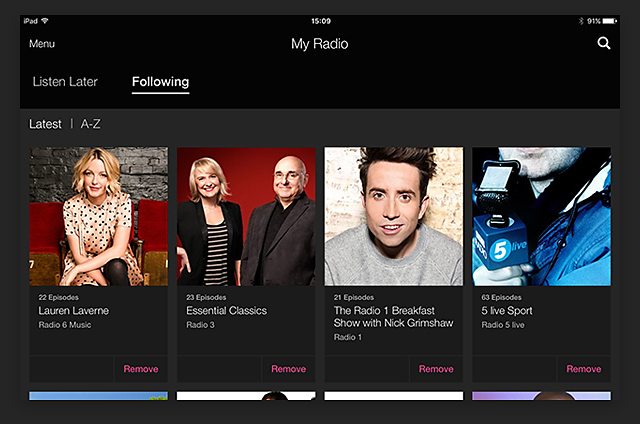
Following on the iPlayer Radio mobile app

Following on the iPlayer Radio website
We’ve also listened to your suggestions and have built a number of ways for you to sort your 'Listen Later’ and ‘Following’ lists. These include by alphabetical order, by when you added items to the lists, by how new the items are and by how soon they’re going to become unavailable.
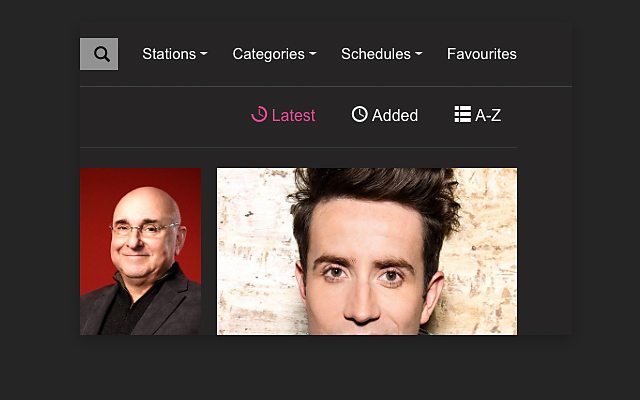
Options for sorting Following on the iPlayer Radio website
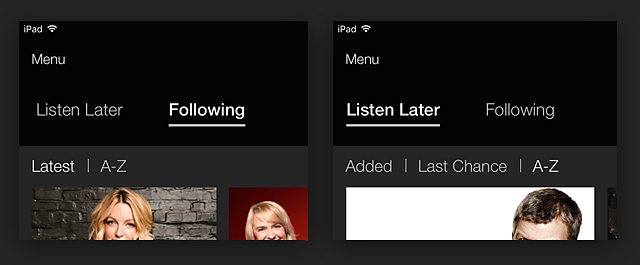
Options for sorting Following (on the left) and Listen Later (on the right) on the iPlayer Radio mobile app
On the iPlayer Radio website we’re introducing personalised radio recommendations for the first time. When you’re signed in to your BBC account we can keep track of the programmes you listen to unless you ask to opt out. Information about those programmes, such as their genre or what other programmes were listened to most often by people who listened to your programmes, is then used to work out what other programmes you might like.
These recommendations are unique to you since they take account of your personal listening preferences; someone else will get a different set of recommendations. What’s more, the more programmes you listen to online, the better our recommendations should get. We’re planning to introduce this in the BBC iPlayer Radio mobile app soon as well.
These recommendations are unique to you since they take account of your personal listening preferences; someone else will get a different set of recommendations. What’s more, the more programmes you listen to online, the better our recommendations should get. We’re planning to introduce this in the BBC iPlayer Radio mobile app soon as well.
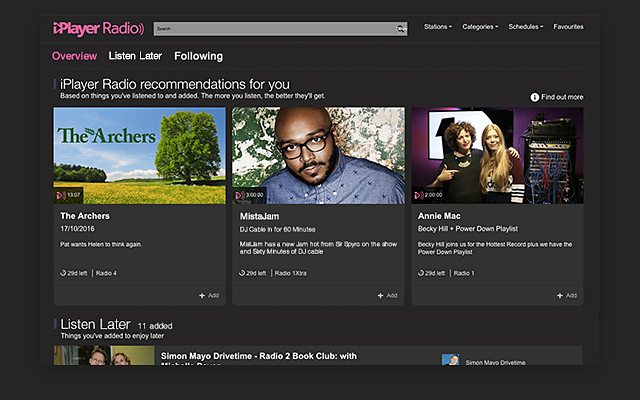
Recommendations on the iPlayer Radio website
We think these changes will help you to better find your way through all our amazing BBC Radio content and discover programmes that you might not otherwise have come across. We’d like to hear how you find the journey.
Since a European Court of Justice ruling in 2014, individuals have the right to request that search engines remove certain web pages from their search results. Those pages usually contain personal information about individuals.
Following the ruling, Google removed a large number of links from certain search results, including some to BBC web pages, and continues to delist BBC Online pages from some search results. These pages are not removed from the Google index entirely, or from BBC Online.
As a contribution to public policy and debate, the BBC has decided to make clear to licence fee payers which pages have been impacted by publishing this list of links.
Each month, we’ll update the list, with the latest removals added at the top. Removals made in 2016 are listed below and those made in 2014 and 2015 can be found here.
You can also find out more about the BBC’s archive policies in my first blog post on this topic published in June 2015.
One important caveat: when looking through this list it is worth noting that we are not told who has requested the delisting, and we should not leap to conclusions as to who is responsible. The request may not have come from the obvious subject of a story.
Following the ruling, Google removed a large number of links from certain search results, including some to BBC web pages, and continues to delist BBC Online pages from some search results. These pages are not removed from the Google index entirely, or from BBC Online.
As a contribution to public policy and debate, the BBC has decided to make clear to licence fee payers which pages have been impacted by publishing this list of links.
Each month, we’ll update the list, with the latest removals added at the top. Removals made in 2016 are listed below and those made in 2014 and 2015 can be found here.
You can also find out more about the BBC’s archive policies in my first blog post on this topic published in June 2015.
One important caveat: when looking through this list it is worth noting that we are not told who has requested the delisting, and we should not leap to conclusions as to who is responsible. The request may not have come from the obvious subject of a story.
Over the last year, the Bitesize teams in Glasgow and Salford have been hard at work designing and shaping the Bitesize Mobile App for iOS and Android. Acting Engineering Manager James Constable outlines the aims behind the app and the challenges faced by his team.
Bitesize reaches 78% of GCSE-aged students in the UK, with 4 in 5 saying that it helped them to feel more prepared for their exams (1). It provides easy access to thousands of study guides and revision materials. In the past Bitesize has offered a one size fits all approach to accessing that content via its website, but when designing the Bitesize App we sought to make it easier for students to find what they need by only showing the content that is relevant to their studies.
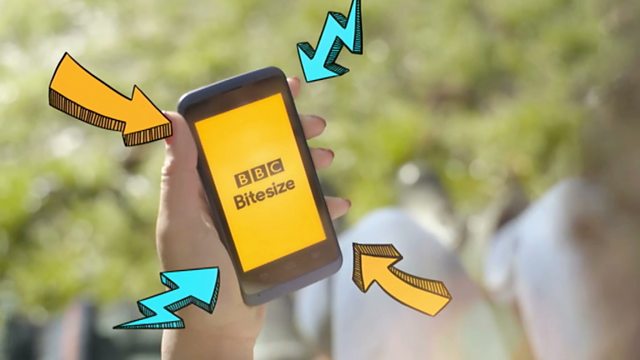
The Challenges
Implementing these requirements offered some particular challenges to the team. The Bitesize Website talks to a varied collection of services to get information about the curriculum and the content associated with it. This includes our content management system, the BBC video metadata API, a triple-store that contains the curriculum ontology, the BBC Quiz engine ACME as well as our own propriety services that render equations and provide access to binary assets.Having the App talk directly to all of these services would have increased complexity massively, and require us to reimplement the business logic for Bitesize in not only PHP (which the Bitesize Website is built using) but also Objective-C (for iOS) and Java (for Android).
With the additional desire to make this experience personalised for the user we knew it was time to build a service that would provide a solid foundation to build our Apps on and abstract those complications into a single place.
The Solution
Our solution was to build out a new data service layer for both versions of the App to talk to that would abstract away that complex business logic, or the need to talk to multiple different sources to retrieve and combine data.Following a microservice architecture, we elected to split the data service layer in two - one for all of the content needs, and another to provide the layer of personalisation - and we called those services Einstein and Newton. The Bitesize Web Services team in Glasgow then set about implementing this strategy.
Each of the data services was designed as a RESTful API that followed a set of API Design Principles we defined. We wanted them to be generic and extensible so we could build new features atop of them and ensure (as much as possible) that the effort to implement those features was minimised across our platforms.
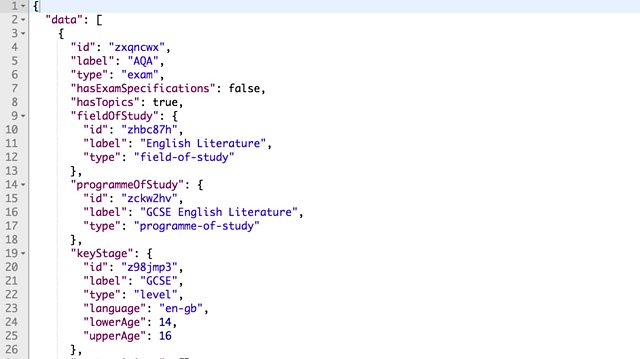
Technical Details
Over the last 18 months we’ve been moving our application and data services away from the BBC’s Forge infrastructure and towards cloud hosting services. Cloud hosting provides us with the flexibility to use modern technologies that we can develop quicker, deploy quicker and - most importantly - get value to BBC audiences quicker.Our team had previous experience of transitioning applications to cloud hosting, using a relatively new platform - Node.JS. We elected to do that again for Einstein and Newton. Node.JS allowed us to lean on the JavaScript expertise that was already abundant in our team and the asynchronous, non-blocking paradigms it provides were perfect for a service that had to be in contact with many other BBC services for each request.
The traffic patterns around the Bitesize app are such that it isn’t always under heavy load. There are distinct peaks around exam time, and troughs around the summer holidays. Hosting the service on the AWS cloud means that we can reduce the infrastructure to save money during these quiet periods, but quickly scale up as demand increases.
A little help from our friends
While building Einstein and Newton we leant on a number of services provided by other teams in the BBC to help provide some of the infrastructure we needed.The MyBBC platform provided us with an easy to integrate way of handling user authentication and storing user preferences in their ID and UAS services.
Our colleagues in Sport provide a system called Morph that provides us with a simple and effective way of pulling data from our database services, combining it and effectively caching that data.
The Platform Services team provide a ready to use API management tool that allowed us to implement key based profiling of our data services, allowing us to effectively monitor their use and understand the their performance.
Effectively combining these existing services meant that we were able to build out our service layer quickly - combining a lot of great work the BBC has already done, with our own team’s expertise in the UK curriculum and educational data models.
Ensuring quality
Right at the start of the project our Engineering team got together to discuss how we would go about testing these services. Traditionally the Bitesize team follows TDD and BDD principles when writing new features. This is backed up by a manual QA process where those features are double-checked to ensure that they implement the required functionality and meet the agreed specification.APIs offer a unique challenge for testing. There isn’t a nice, visible interface to compare to a UX specification - the data is exposed as JSON structures that are primarily strings of text.
We decided that we didn’t want to submit our Test team to manually inspecting JSON structures and instead elected to have our developers and testers pair together to write integration tests for each feature that get run whenever we deploy a new version of the API.
We coupled this with an API spec written in API Blueprint. This open standard allowed us to communicate the API requirements and quickly provide mock services to the team building the native clients.

Automation all the way
One of the big changes we made was to go from manually releasing our code between integration, test and live environments to a fully automated deployment process.Using Jenkins, an open source Continuous Integration platform, we were able to set up a pipeline that runs our unit tests, and performs static analysis on any changes to the code. If these checks pass then we automatically promote the code to the next environment and run a suite of integration tests. This ensures that what is deployed continues to meet the requirements of clients interacting with the API.
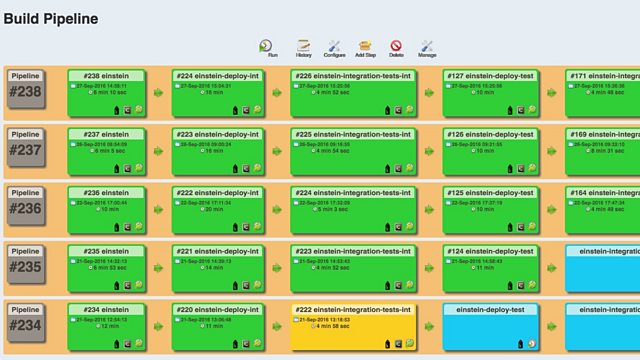
We also run the integration tests every night against each environment. Notifications of these appear in our Slack channel, allowing us to see immediately every morning whether any problems have occurred since the last deployment.
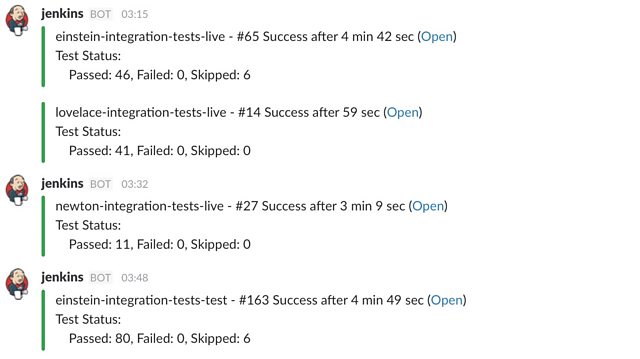
The Next Steps
As the App evolves we’ll add more features and expand the capabilities of these APIs. We’ll also be updating the Bitesize Website to bring the new features that the App provides to our web users - reusing the platform provided by Einstein and Newton to simplify that process.(1) Based on research conducted by EdComs Research who specialise in research with teachers, learners of all ages, parents and education stakeholders.



